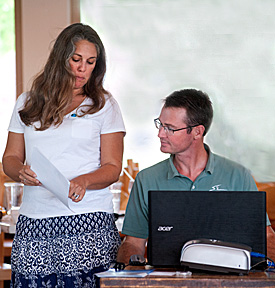 Tiffany Frey and Mike Kromrey are both executive directors of non-profit agencies that monitor and help correct water issues in the Springfield, Missouri area. An avid fly fisherman, Kromrey has a B.A. and M.A. in biology while Frey has an associate's degree from Cottey College and a B.S. from Missouri State University. (Photo by Vince Rosati) Tiffany Frey and Mike Kromrey are both executive directors of non-profit agencies that monitor and help correct water issues in the Springfield, Missouri area. An avid fly fisherman, Kromrey has a B.A. and M.A. in biology while Frey has an associate's degree from Cottey College and a B.S. from Missouri State University. (Photo by Vince Rosati)
A meeting of the Democratic Alliance recently featured Mike Kromrey, executive director of the Watershed Committee of the Ozarks and Tiffany Frey, executive director of the James River Watershed Basin. Their main focus was to inform everyone regarding their organizations' roles in creating effective water management policies in and around Springfield, Missouri.
The area consisting of the James River Basin was described as being one million acres of land in portions of eight counties. According to both leaders, projects targeting non-point source pollution or pollution caused by the path of water running over or through the ground rather than treated wastewater discharged from the pipes of industrial facilities or domestic wastewater treatment plants have a more major impact. In urban areas, Kromrey said that in terms of non-point source pollution that pet waste was a huge source of that contamination.
"Think about the name of the town," Kromrey said. "We have over 100 Springs" recharged by water from the Ozark Aquifer.
That Kromrey takes his responsibility for effective water management seriously was evident. His organization was one of the first Governor's Natural Resources Awards of Excellence presented by Missouri Governor Jay Nixon at the conference on natural resources held in Springfield in November 2014.
Frey agrees with Kromrey when it comes to connecting school kids to nature. "People need to understand that water is valuable," she said. As an example of what happens when due diligence is disregarded, was the mention of Flint, Michigan's water crisis where cost-cutting measures led to the water being contaminated with lead and other toxins.
Listing the biggest threats to water quality, both agreed on these scenarios:
Increased intensity of storm water run-off due to climate change
Rampant use of fertilizers creating chemical run-off
Uneducated people adding to pollution
Disregard of city ordinances that may be purely voluntary
The Tri-State Water Coalition was mentioned briefly. Regarding water supply problems in a 50-year outlook, the speakers think that this organization's solution would be to "redistribute existing reservoirs.
"Springfield may need to look for a regional solution," Kromrey concluded.
How smart are you regarding the Water(shed). Take this quiz.
- Non-point source pollution is a term for pollution that comes from different sources in a watershed. What is an example of a non-point source pollution? a)Failing septic tank; b)Sediment from erosion; c)Oil from a leaky vehicle; d)All of the above.
- What type of event prompted the creations of both WCO & JRBP? a)Trash in the river; b)Algae blooms; c)Urban growth.
- A like, stream or wetland is--- a)Not affected by the land around it; b)only as healthy as the land around it; c) healthier than the land around it.
- The surface water is connected to the ground water-- a)True or b)False.
- The "sewer" grates along Springfield's streets convey water to one of the city's two water treatment facilities-- a)True or b)False.
- The amount of water on Earth today is (fill in) the amount of water here 100 years ago-- a)less than; b)the same as; c) more than
- A large, natural underground area in what water accumulates below the ground's surface is called a/an-- a)wetland; b)aquifer; c)watershed.
- Which of the following is one of the causes of stream bank erosion? a)removal of trees and grasses; b)driving a car; c)walking the dog.
- What law, signed in 1972 with bi-partisan support, was a response to pervasive water pollution including the Cuyahoga River catching fire? _____
- What are two common contributors of bacteria pollution to local waterways? __________ & ________
- Nutrient pollution can come from manure, sewage, fertilizer, runoff or sediment from erosion. What are two effects nutrients can have in waterways? a)taste and odor issues & oxygen deprivation; b)algae blooms & toxicity to fish; c)all of the above.
- What watershed are we in right now? a) James River Watershed; b) Sac River Watershed; c)Beaver Reservoir Watershed.
<--->
Answers: d, b, b, a, b, b, b, a, Clean Water Act technically, the name of the law is the Federal Water Pollution Control Act), animals & people, c, a.
Editor's update: The United States Environmental Protection Agency's Region 7 2016 decision document showing bodies of water in Missour in compliance with the clean water act and those still requiring TMDL regulation (the maximum amount of a pollutant that a body of water can receive while still meeting water quality standards imposed by the U.S. Clean Water Act) may be found here. Go Back |







